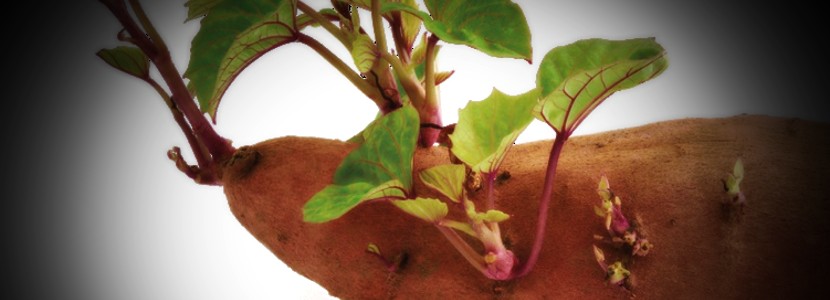Sweet potato (Ipomoea batatas), commonly called sweet potato (from Taino), camote (from nahuatl camohtli) or boniato, is a plant of the Convolvulaceae family, cultivated in much of the world for its edible tuberous root. Unlike the potato sweet potato is not a tuber, it is a reserve root.
Sweet potato is versatile and its genotypes can be selected to meet the needs of a particular use.
- Sweet potato storage roots are consumed directly as food. The tips of the foliage are an important protein resource although they are not used very often.
- In the tropics, edible roots are not stored for long periods due to the indeterminate growth of sweet potatoes and the fact that multiple planting allows harvesting of reserve roots for most of the year.
- Both the roots and foliage serve as animal feed.
- Roots can also be used as a starch resource and for fermentation products such as: wine, ethanol, lactic acid, acetone and butanol.
The People’s Republic of China produces about 75% of the world’s sweet potato production. Making it the country’s second after rice.
In general, sweet potato is an important food crop in many tropical countries.
In the United States it is produced for consumption as a vegetable supplement and in many regions it is strictly associated with religious holidays.
Feed material according to Reg. (EU) No. 68/2013
Catalogue of feed materials (Tubers of Ipomoea sweet potatoes L. regardless of their presentation), inscribed in the latter under number 4.9.1.
Mandatory compliance declarations “Humidity when < 75% or > 80%”.
It complies with Royal Decree 465/2003 and subsequent modifications, on undesirable substances in animal feed.
[register]
Procurement Process
It is native to the South American tropical region and its cultivation was widespread throughout the Antilles since ancient times.
It seems that Spanish navigators took sweet potato to the Philippines and the Moluccas, from where the Portuguese then took it to India, China and Japan.
The ideal conditions for its cultivation are:
An average temperature above 21º C, a humid environment (80-85% RH) and good luminosity during its growth period. The minimum growth temperature is 12º C. It withstands heat well.
Wind. It tolerates strong winds due to its creeping bearing and the flexibility of its stems.
The ideal texture is loam-sandy, together with a granular structure of the soil.
It tolerates moderately acidic soils, with a pH between 4.5 to 7.5. Where a pH of 6 is optimal.
Reproduction by means of seeds is hardly practiced since its flowers bear fruit poorly and the grains are late in developing the whole plant. It does not guarantee quality plants and it is only used in Genetic Improvement to obtain new varieties.
Multiplication by tubers or roots gives a very good production and it is carried out when there are not enough branches.
Nutritional Value
- Sweet potato is a high energy food.
- Its roots have a total carbohydrate content of 25-30%. From which 98% is considered as easily digestible.
- It is an excellent source of provitamin A carotenoids. However, it varies between different types and cultivars in the range between 0 and 8000 IU/100 g.
- It is a source of vitamin C (20-30 mg/100 g), potassium (200-300 mg/100 g), iron (0.8 mg/100 g), and calcium (11 mg/100g).
- The protein content content is low. Ranging from 2.5 and 7.5% of the dry weight depending on the genotype. Its amino acid composition is relatively well balanced, with a higher percentage of lysine compared to that of rice or wheat, but it has a somewhat limited leucine content.
Table 1.Sweet potato chemical composition
Use in animal feed
Due to its physical structure and the fact that the root is only used when split, it cannot be used in feed mills. Therefore its use is more widespread in ruminants than other species. Its high starch content added to soluble sugars is above 70%, making it a typical energetic raw material with a similar behavior to that of cereals.
Sweet potato starch is composed mostly of amylopectin (60-70%) which is easily digestible in all species. Due to this, it is important to pay special attention to rumen acidosis problems.
Although ruminants have great adaptability to diets of high energy concentration, the success of supplementation depends on the progressive adaptation of the rumen.
➢ It is convenient to start with low amounts per animal and increase until the goal is reached. Example: Target: 4 kg/individual. Start with: 500 grams/ind for 2 days, continue with 1 kg/ind for 3 days, and increase 1 kg every 3 days until reaching the level of 4 kg/individual.
Being a raw material that is not used in feed mills, its use in monogastrics is reduced to animals fed directly in the field “pigs in the wild”. In table 2 there is a small revision on levels of inclusion and different ages where it has no restrictions. The only disadvantage is its low protein content.
Table 2. Use of sweet potato in pigs
In free-range chickens, good results have been obtained with inclusions up to 20%
Conclusions
Sweet potato is an excellent source of starch and therefore energy. Its only disadvantage is that it can’t be used in feed mills. However it is a good alternative for direct feeding in all species. It is important to remember that it has low protein levels.
As all raw materials with high levels of humidity, require certain storage precautions in order to avoid contamination. It is easily silaged as long as the precaution of not leaving air pockets is taken. If it is not ensiled it is convenient to store it as shortly as possible.
[/register]
